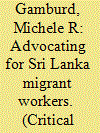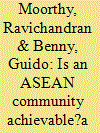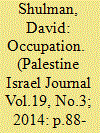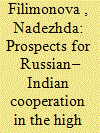| Srl | Item |
| 1 |
ID:
087033


|
|
|
|
|
| Publication |
2009.
|
| Summary/Abstract |
Nearly a million Sri Lankan women labor overseas as migrant workers, the vast majority in the Gulf Cooperation Council (GCC) countries in West Asia. They are poorly paid and vulnerable to a wide variety of exploitative labor practices at home and abroad. Despite the importance of worker remittances to Sri Lanka's national economy, and in spite of the nation's history of organized labor and active political participation, migrants have received only anemic support from the state, labor unions, feminist organizations, and migrant-oriented nongovernmental organizations. The article contextualizes Sri Lankan migration within larger-scale economic dynamics (such as global capitalist policies and processes) and local-level ideological formations (such as local political histories and culturally shaped gender norms). The author argues that political freedoms in destination countries have a significant effect on organizing activities in both host and sending nations. Comparing the Sri Lankan and Philippine situations, the author contends that the vibrant activism in the Philippines correlates with the liberal organizing climates in the European Union and in East and Southeast Asia, while the paucity of organizing in Sri Lanka correlates with the strict repression of guest workers in the GCC. Compared to other destinations, the GCC countries give workers (particularly women) less chance for autonomous activities, are less open to labor organizing, and are less responsive to political protest.
|
|
|
|
|
|
|
|
|
|
|
|
|
|
|
|
| 2 |
ID:
091600


|
|
|
|
|
| Publication |
2009.
|
| Summary/Abstract |
The authors' theory contributes an alternative domestic politics pathway to traditional bargaining models of war termination. In bargaining models, the rational updating process that produces an overlapping bargaining space can develop a significant lag, which extends the war beyond a logical ending point. The authors posit that a change in the domestic governing coalition is often necessary to kick-start this updating process once it has become bogged down through preference, information, and entrapment obstacles. The authors demonstrate that domestic coalition shifts are a critical path to peace, using survival analysis techniques on Bennett and Stam's (1996) war-level data set of wars (1862-1990) and a new belligerent-level data set of wars (1945-2006). These tests show that because war policies can become institutionalized over time, there is a very strong link between coalition shifts and war termination.
|
|
|
|
|
|
|
|
|
|
|
|
|
|
|
|
| 3 |
ID:
117654


|
|
|
|
|
| Publication |
2012.
|
| Summary/Abstract |
The formulation "ASEAN Community" has been criticized for being too elitist and lacking serious efforts to solicit public opinion. This article examines how the people in Indonesia, Malaysia, and Singapore view the concept of "community building" and the obstacles this initiative may encounter.
|
|
|
|
|
|
|
|
|
|
|
|
|
|
|
|
| 4 |
ID:
129849


|
|
|
|
|
| Publication |
2014.
|
| Summary/Abstract |
The phrase "Obstacles to successful negotiation" has a somewhat distant ring to it. I was a little taken aback when I first read it. It's an abstraction, and far too hopeful at that. Obstacles could in theory, be removed. Maybe someday they will be. But, for now, anyone who knows the reality of what is happening on the ground in the south Herbon Hills isn't likely to think in terms of obstacles.
|
|
|
|
|
|
|
|
|
|
|
|
|
|
|
|
| 5 |
ID:
139600


|
|
|
|
|
| Summary/Abstract |
The paper examines emerging prospects for Russia–India cooperation. While the two countries can collaborate in various areas of mutual interest, the paper identifies possible challenges and effects on the cooperation in the Arctic region. The sanctions imposed by the West could impede Russian energy projects in the Arctic. This could force the state to find a way to replace Western technologies through enhancing capacities of national industry and developing cooperation with other states, including Asian countries. This shift is also bolstered by the political interest to strengthen the position of Russia in the Asian region as a whole, and to increase the country's energy security. The paper provides an overview of the Russian and Indian interest and policy in the Arctic, and presents the perspectives and challenges for both countries.
|
|
|
|
|
|
|
|
|
|
|
|
|
|
|
|